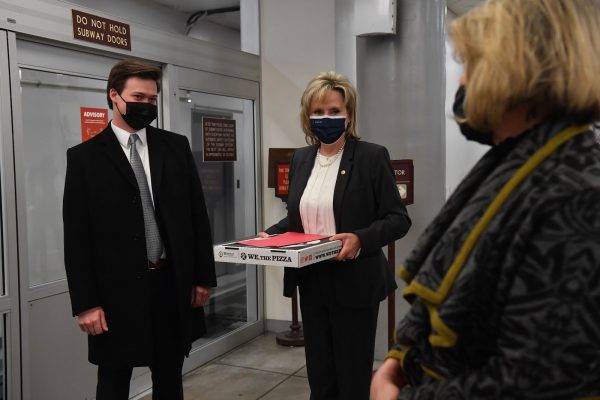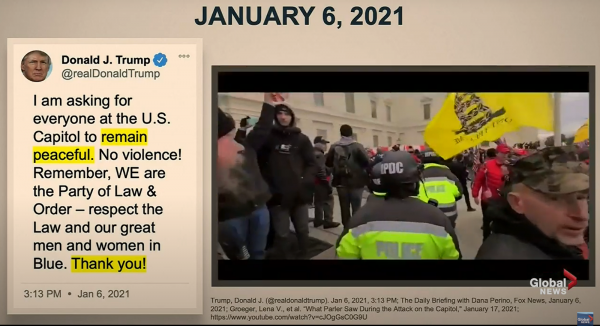The House of Representatives presented its opening arguments in former President Donald Trump’s second impeachment trial on Wednesday, Feb. 10. Democrats presented a litany of first-hand video evidence of the Jan. 6 breach of the Capitol building captured from Parler, internal security footage, and a variety of statements and tweets made by President Trump leading up to and proceeding both the Nov. 3 general election and the Jan. 6 Joint Session of Congress.
Democrats assert that the former president incited the crowd to break into the Capitol, where several people lost their lives, including one woman shot by police inside the building. However, as of press time, the Democrats’ claim so far hinges on narratives carried by major left-leaning media outlets in the weeks following the break-in, which have been criticized as incomplete and misleading.
Rep. Raskin’s basis for the claim that Trump “celebrated” those who committed violence is the video Trump tweeted before he was banned from Twitter, three hours after protestors entered the building. After calling for no violence and asking his followers to go home, he said “We love you. You’re very special.”
House Manager Rep. Jamie Raskin (D-MD) took the lead in presenting, focusing on both the damage the break-in caused and Trump’s tweets and reactions, and lack thereof, to the event: “If anyone had a doubt as to [Trump’s] focus that day, it was not to defend us it was not to console us, it was to praise and sympathize and commiserate with the rampaging mob. It was to continue to act as ‘Inciter-in-Chief’, not Commander-in-Chief, by telling the mob their election had been stolen from them.”
‘The Big Lie’
Raskin followed closely with the prevailing mainstream media narrative that there is “no credible evidence” of fraud in the 2020 election, calling Trump and his supporters’ assertion to the contrary “The Big Lie.”
Success
You are now signed up for our newsletter
Success
Check your email to complete sign up
“Even after that vicious attack, he continued to spread ‘The Big Lie’… But Donald Trump refused to accept this loss even after this attack. And he celebrated the people who violently interfered with the peaceful transfer of power for the first time in American history and did that at his urging.”

Rep. Raskin’s basis for the claim that Trump “celebrated” those who committed violence is the video Trump tweeted before he was banned from Twitter, three hours after protestors entered the building. After calling for no violence and asking his followers to go home, he said: “We love you. You’re very special.”
The Democrats made frequent reference to that line in their opening arguments, saying that “We love you. You’re very special” constituted tacit support for those who had committed acts of violence and vandalism.
The full text of Trump’s 61-second video is as follows: “I know your pain. I know you’re hurt. We had an election that was stolen from us. It was a landslide election and everyone knows it. Especially the other side. But you have to go home now. We have to have peace. We have to have law and order. We have to respect our great people in law and order. We don’t want anybody hurt. It’s a very tough period of time. There’s never been a time like this where such a thing happened, where they could take it away from all of us. From me, from you, from our country. This was a fraudulent election, but we can’t play into the hands of these people. We have to have peace. So go home. We love you, you’re very special. You’ve seen what happens. You’ve seen the way others who are treated that are so bad and so evil. I know how you feel, but go home and go home in peace.”
A three-pronged case
House Manager Sen. Joe Neguse (D-CO) broke down the Democrat case into three points: “The Provocation, The Attack, and The Harm.”
In his presentation, Neguse argued that “The Big Lie” around election fraud was a narrative used by Trump because the former president was upset he lost. The “Stop the Steal” campaign and events were used to build public sentiment, culminating in Trump’s statement “If you don’t fight like hell you’re not going to have a country anymore” at the White House in the morning of Jan. 6.
During the presentation, the House managers took aim at citizens protesting at the Capitol building and at earlier events in the wake of the Nov. 3 election — focusing especially on the fact that some protesters bore arms. Many times, Democrats’ arguments relied on “authoritative sources”: headlines and excerpts from big articles from major media outlets.
Rep. Eric Swalwell (D-CA) repeated Neguse’s arguments that Trump systematically and premeditatedly primed his believers to violent action from well before the time the election began, saying Trump claimed: “The only way their victory would be lost is if it was stolen.”
“So that way President Trump was ready if he lost the election to light the match,” Swalwell said.
A repetition of the ‘Court of Public Opinion’
In fact, for more than seven hours, Democrats repeated the same rhetoric over and over again from slightly different angles. Swalwell described the small minority, who acted with behavior more consistent with agents provocateurs from revolutionary groups than Trump’s supporters, that smashed windows and walked into the building as “Thousands of people who were armed to the teeth”.
House managers did as much as they could to pander to sentiments and prejudice since the facts they had to present were neither greater nor more persuasive than what has already been aired in the court of public opinion during the 5 weeks since the Joint Session.
Rep. Ted Lieu (D-CA), a Taiwanese immigrant, asked “Is this America?” before telling a story about how he’s from a poor family, claiming Trump ran out of “non-violent options to retain power.” Rep. Madeleine Dean (D-PA) referenced headlines from mainstream media about court cases that were dismissed on procedural or standing issues before a hearing of facts or evidence could occur in order to assert Trump intended to ”steal votes from Americans so he could steal the election for himself.”
While House Delegate to the Virgin Islands Stacey Plaskett conflated the violence she described as “foreseeable” and “not planned in secret” to being the same level as 9/11. Plaskett claimed Trump “spent months cultivating groups of people who following his command repeatedly engaged in real, dangerous violence”.

Rep. Joaquin Castro (D-TX) took a 3:13 p.m. tweet completely out of context, lambasting the President for ending his sentence with “thank you” because it, apparently, did not call for an end to the violence.
“You’ll notice one of the things he says to his mob, to these insurrectionists, rather than to stop or to leave, was to say ‘thank you.’ Thank you. Thank you for what?,” asked Castro. “Thank you for shattering the windows and destroying property? Thank you for injuring more than 140 police officers? Thank you for putting in danger all of our lives and the lives of our families?
“How about instead of thank you, Donald Trump on that day acted like our Commander in Chief and stopped this as only he could, and told those people to leave.”
Trump’s actual tweet, which was presented via video at the time of the statement, said: “I am asking for everyone at the U.S. Capitol to remain peaceful. No violence! Remember, WE are the Party of Law & Order — respect the Law and our great men and women in Blue. Thank you!”
Rep. Swalwell, who was caught with his hands in a Chinese Communist Party “honey pot” with a special agent in December, claimed he was so scared for his life during the break-in that he said he “sent a text message to my wife: ‘I love you and the babies. Please hug them for me.’”
Opening arguments not without flaws
But the Democrats’ argument is far from waterproof. Since the intent to use the protests at the Capitol on Jan. 6, an event organized by Trump’s supporters intended to be peaceful and embody the spirit of democracy, was indeed being used by extremists, both left-wing and right-wing, on social media for weeks in advance, the question arises: Where was either the national security or law enforcement response?
Why was a large perimeter around the Capitol not set up in advance to prevent this tragedy from happening in the first place? How could the building, where all the Senators, all the Representatives, and the Vice President and his family were all present, possibly be protected only by a few street cops using 3-foot tall metal barriers? How could security allow the group to be within a few dozen feet of the steps of the Capitol when they knew a crowd of hundreds of thousands of people would assemble?
Why did Capitol Police open doors and remove barricades to let the front lines of the insurgents through the doors? Why did D.C. law enforcement reject offers of federal help to quell the mob? Why were, as the House’s own security footage showed during arguments, tactical teams present to prevent insurgents from entering certain parts of the building while openly allowing them to enter others?
At one point during the seven hours of repetition, the “thousands of people who were armed to the teeth” were later described as carrying a “crutch, a hockey stick, a bullhorn, and a Trump flag.” If the insurgents had actually been “armed to the teeth” as described, the casualties and damage to both democracy and the future of the free world that day would have been catastrophic, and the fault would have fallen squarely in the hands of national security and law enforcement who both arranged and allowed such lax measures and protocols when, apparently, everyone knew what was coming.
The people who smashed windows, knocked down barricades and doors, and entered the Capitol screaming threats and obscenities are tied to Trump primarily because they had Trump flags and wore MAGA hats. In one video Dems showed, a manager remarked “the first person through the door is carrying a Trump flag.”
The Impeachment Trial continues on Thursday. Each side is permitted up to 16 hours, or two days, of time to present their case. Afterward, Senators will have a total of four hours to question each side, divided equally between both parties.
Follow us on Twitter or subscribe to our email list
















